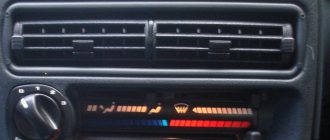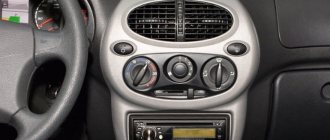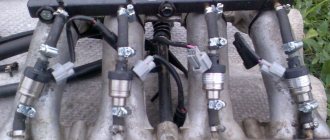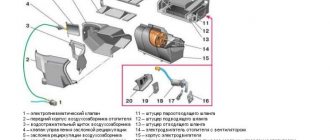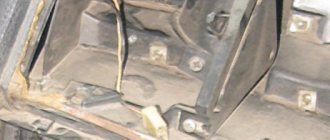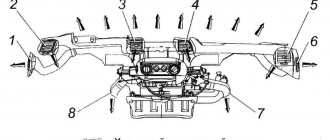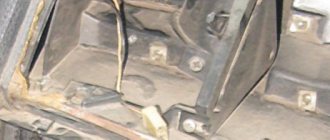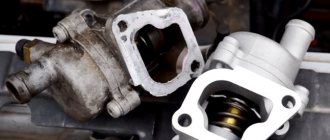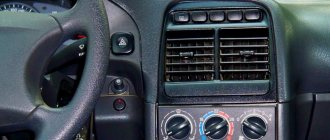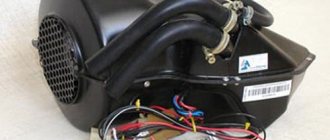Causes of foggy windows and poor performance of the NIVA stove. Is modernization of the NIVA stove necessary or not? Snail (heater radiator blower motor) from VAZ 2108. Detailed discussion of all the nuances that you might not immediately think about. How the Niva's interior heating system works. Correct control of air flows for heating the interior of a VAZ NIVA. Ventilation of the NIVA interior. Causes of poor interior ventilation of the Niva.
NIVA stove.
Measurement of gravity flow and motor. Nostril selection. Dust/Snail 2108. Hood deflector 2h https://youtu.be/unAxnFmuLtQ
Replacing the interior heater tap without draining the antifreeze.
NIVA. All methods for removing the stove tap https://youtu.be/sMzrorg62ks
Stretching the ceiling of a NIVA, VAZ car.
Special "chips". How dust gets into the NIVA interior https://youtu.be/HmSpTJ1vWGM
Inspection and purchase of used NIVA car part 1. Details. Where to start choosing NIVA https://youtu.be/yadIbZ1rUsc
Overnight in Niva.
Live in a short field without a tent. We cook food in NIVA. Security https://youtu.be/_IHH1AuAPG8
NIVA stove.
Modernization from 2108 – pros and cons. The windows are foggy, the stove is not heating well - reasons https://youtu.be/3ch3Fh8Xx38
Subscribe to Andrey Lapochkin’s channel: “For Yourself.” https://www.youtube.com/user/SamiDlyaSebya1 Here you will find a lot of useful information on the maintenance and repair of the NIVA VAZ 21214, VAZ 21214m, VAZ 21213, Chevrolet Niva. Lots of tips and tricks that you won’t see on other channels. All videos were shot in a detailed style covering the topic of repairing or finding the causes of malfunctions of the Niva car and not only Niva. There are videos for NIVOvod beginners. How to overcome obstacles and dangerous areas on NIVA. The channel has other interesting videos about travel and adventures. Holidays on the Black Sea. Fishing, travel. Underwater filming. Tourism. Jokes, funny stories. Dollar exchange rate analytics. Search for gold, search for treasures. How to pump up your body at home and have time to prepare for the beach season with very little effort, time and money. On the channel you will find many videos on how to start shopping on AliExpress (ALIEXPRESS). Tactics for communicating with sellers on AliExpress (ALIEXPRESS). How to start working with video camera SJ4000, SJ5000. How to make video camera settings SJ4000, SJ5000. How to shoot with video cameras. And much more on various topics.
Video NIVA stove. Modernization from 2108 – pros and cons. The windows are fogged up, the stove is not heating well - the reasons for 1h channel Andrey Lapochkin
Do-it-yourself modification of the stove on Niva 21213 is necessary if the car’s heating system malfunctions. There is no point in delaying this, because uneven thermal regulation leads to foggy windows or icing. In any of these cases, the view of what is happening on the road deteriorates. The malfunction causes wear of individual elements of the device or manufacturing defects.
Fault Diagnosis
The stove supplied as standard will need to be modified for preventive purposes. The procedure will not take much time, but it will prevent many problems in the future. Driving experience suggests that the first severe frosts will undermine the “health” of the device. The list of main weaknesses is as follows:
- the optimal operating temperature range for model 2121 is from -5 to +10°C;
- inability to warm up the air in the cabin if outside is -8°C or lower;
- when the blowing power increases, the temperature does not increase;
- When driving in 2nd gear, the noise from the Niva's stove becomes significant.
That is why it is better to take the necessary measures in advance. The driver has few alternatives. On the one hand, everything remains in its place. The heating device is used at minimum power. During mild winters this is still tolerable, but with the onset of real cold weather the conditions will become unbearable. On the other hand, it's easy to spend a few hours rectifying the situation.
Further developments proceed as follows. If the heating in the car is running at ½ power, you can limit yourself to minor repairs. The main thing is to make sure that there are no noises or extraneous knocks, otherwise the Niva 21213 should immediately go for a technical inspection.
The presence of an unpleasant sound indicates the need to replace the device. A specialized retail network offers ready-made options for heating mechanisms for Niva. If desired, it can be assembled independently.
The second option is considered more preferable. When you assemble it yourself, you have the opportunity to literally personalize the stove. To do the work yourself, you will need to visit a specialized store or market to buy spare parts.
When purchasing, original parts or analogues are selected. The main thing is that they have a quality certificate. Otherwise, they cannot be installed. It would be useful to rewrite the technical data of the vehicle so as not to exceed the parameters recommended by the manufacturer.
The device of the stove of the Niva Chevrolet car
The Chevrolet Niva is equipped with a liquid-type heater. It supplies warm air to the cabin and cools the engine, overheating of which can lead to disastrous consequences and costly repairs.
Without air conditioning
The Chevrolet Niva heating system consists of the following elements:
- ventilation duct;
- windshield heating duct;
- intermediate body;
- air intake filter;
- fan;
- interior heating duct;
- foot heating duct;
- heater radiator.
The intensity of the hot air supply is regulated using dampers. The air duct system distributes the heat flow to various areas of the cabin: windshield, side windows, legs, doors, etc. In addition, there is a four-speed air supply switch.
Heating system for the interior of a Chevrolet Niva car, where 1 is the side deflector air duct; 2 — windshield air duct; 3 - intermediate body; 4 - intermediate air duct; 5 — outside air filter housing; 6 — fan housing of the heating and ventilation system; 7 — central deflector; 8 — air duct for blowing the front passenger’s feet; 9 — facing of control units; 10 — front air duct for blowing the legs of rear seat passengers; 11 — rear air duct for blowing the legs of rear seat passengers; 12 — heater assembly; 13 — air duct for blowing the driver’s feet; 14 - side deflector
With air conditioning
The air conditioning system allows you to regulate the temperature and humidity in the cabin. Before turning on the air conditioner, the heater fan is turned on, and the temperature control knob is set to minimum. Almost the entire air conditioning system is located in the engine compartment. Only the evaporator is brought into the cabin between the heater and the electric motor, providing heat exchange between the incoming air and the refrigerant.
Heater and air conditioner diagram, where 1 - heater housing; 2 — inlet pipe of the heater radiator; 3 — heater radiator outlet pipe; 4 — air conditioner evaporator housing; 5 — evaporator outlet pipe; 6 — evaporator inlet pipe; 7 — fan housing; 8 — control cable for the external air supply damper
As the refrigerant moves through the evaporator tubes, it absorbs heat and turns into a gaseous state. The evaporator fins are cooled, and the fan directs cold air into the cabin and reduces the temperature. Gaseous refrigerant from the compressor under pressure enters the condenser, cools and turns into a liquid state. After this, the liquid is supplied to the receiver, and from it to the evaporator reducer, where it again turns into a gaseous state. A new cycle begins.
Technical details of the procedure
The efficiency of the new heating system on Niva will be determined not by the cost of the purchased parts, but by their quality. To operate, you will need the following elements: a car resistor, a figure-eight heater and a “snail”. It is a mistake to believe that only “original” spare parts are suitable for repairing a heating device. The main requirement is technical compatibility.
If in doubt, a drawing of the heating system will provide clarity. The further procedure is as follows:
- Cut a new mounting hole. This is done carefully, because the reliability of the heating system’s operation depends on the quality of the preparatory process. It is recommended to place the engine as low as possible in the air duct, otherwise the device will rest against the hood. This should not be allowed to happen, otherwise the stove fan will not last long.
The heating system of a new model is checked by test switching on. It is recommended to switch modes smoothly. The device must remain on each of them for at least 5-7 minutes. The driver’s task is to make sure that the operation of the system is not accompanied by extraneous noise and vibration.
Fan replacement
Experienced car owners recommend not stopping there and continuing to modify the stove by tuning the fan.
Some people suggest getting rid of the fan installed by the manufacturer and installing a figure eight fan instead.
If you also decide to carry out such a replacement, you need to additionally decide whether you will leave the original control of the stove or also replace it with a “eight” analogue.
Having decided on the second option, take care of purchasing the following additional items:
- fan speed switch;
- additional resistor for the stove.
So, after you have completely prepared all the necessary components, you can proceed directly to the process of modifying the fan.
Initially, you should dismantle the old air supply box. Unfortunately, despite the fact that this requires unscrewing only four nuts, it will not be possible to do this without outside help. Your partner will need to hold the screws under the hood while you unscrew them using a wrench.
After this, you can easily remove the air intake. Clean it if it needs it, and then cut away a small amount of the plastic to provide enough space for the new fan to operate.
Original parts vs analogues: practical advice
As mentioned earlier, such a choice does not affect the quality of the heating system. At the same time, car mechanics make several reservations. For those who plan to use VAZ stoves, it would be useful to check the power system. It is different for some modifications. That is why all actions are consistent with the drawings.
It is permissible to use the VAZ 2108 heater, provided that two recommendations are followed. Firstly, the mounting socket is 1-2 cm larger than the size of the device. The additional area will reduce the vibration impact. Secondly, the switch is installed taking into account the specifics of the VAZ heating system. You will have to tinker less when minor modifications to the system are needed.
The ventilation system is updated in 1-2 hours, depending on the degree of wear of the engine.
If the factory-installed “snail” has no signs of physical wear, you only need to replace the heater “engine” itself.
It’s worse if the factory equipment of a Chevrolet model has manufacturing defects. A complete replacement of the device is recommended. This will save time.
The operation of the heating system determines the comfort and safety of driving. The driver constantly monitors the system's performance. If extraneous noise appears, it is necessary to urgently carry out a technical inspection.
The heater in the car is not working well - what to do?
With the arrival of cold weather, some drivers are puzzled by finding the reasons why the heater in the car does not heat well. Moreover, sometimes the stove in the car begins to work so poorly that it becomes absolutely unable to warm the interior. In addition, in severe frost the situation is further aggravated by glass freezing. What to do in such cases?
In fact, there are not many reasons why the heater in a car may not work efficiently, and below we will look at each of them.
At the end of this article, watch a video with a detailed description of the reasons why stoves in cars do not work well and how to eliminate them.
In the meantime, you are figuring out the reasons why the stove is not heating well, we recommend that you pay attention to alternative methods of heating the car interior:
What to do if the stove in the car does not heat well
If the stove in the car does not heat well or does not work at all, then you first need to determine the cause of the malfunction and then eliminate it. Most problems with a car heater manifest themselves as follows:
- The stove in the car does not heat well;
- The heater in the car blows cold air;
- The stove in the car sometimes works, sometimes it doesn’t (it blows either cold or hot air);
- The air from the stove in the car is quite hot, but it blows weakly;
- The heater in the car does not work (does not turn on).
In the table below, we have combined the possible reasons for the malfunction of the car's interior heating system, described how they can affect the operation of the stove, and listed ways to eliminate them.
1. The stove does not heat well; 2. The stove blows cold air; 3. The stove blows either cold or hot air.
1. Remove air from the system (simple method here); 2. If air is not removed or appears again, check whether the cylinder head gasket is broken.
1. The stove does not heat well; 2. The stove blows cold air.
1. Check whether the cable has come off the damper control levers or the heater tap; 2. If the heater tap is faulty, it must be replaced.
1. The stove in the car does not work (does not turn on); 2. The air from the stove is quite hot, but it blows weakly and only at high speed.
1. The stove does not heat well; 2. The stove blows cold air; 3. The stove blows either cold or hot air; 4. The stove does not work (does not turn on).
Fan doesn't work
The most common reason, it happens, is that the fan does not work, it simply does not blow, and, accordingly, warm air does not flow well into the cabin, or rather does not flow at all. Of course, the heater radiator will heat up, but for heating the entire cabin, this is extremely insufficient.
The fan or the electronics that control it need to be replaced. Or look at the fuse, often it simply blows and needs to be replaced .
Preventing the operation of the stove in the car
In order for the stove in your car to heat well and not let you down at the most inopportune moment, you need to follow a few simple tips.
- Keep the radiator clean. Light contamination from the outside of the radiator can be removed with a vacuum cleaner. Flushing the engine cooling system, with which the heater radiator is inextricably linked, will help get rid of internal deposits and blockages in the channels.
- Use good antifreeze . High-quality antifreeze is the key to long-term operation of not only the stove in the car, but also the engine. Remember this and do not forget to replace it in a timely manner.
- Change the cabin filter more often . A clogged cabin filter will certainly create problems not only for the operation of the stove, but also for the air conditioning and cabin ventilation system as a whole. In addition, dust and pollen deposited in the filter can pose a serious health hazard (especially for allergy sufferers).
If, at an outside temperature of minus 25 °C, your car’s heater heats the interior to +16 °C from below and up to +10 °C from above, then it can be considered quite serviceable. To avoid problems, it is recommended to carry out preventive measures in a timely and responsible manner that will allow you to enjoy a comfortable ride in a well-warmed-up car.
And remember, the longer the service life of the machine, the more attention its heating system requires. This applies to all cars, regardless of country and manufacturer.
Replacing the faucet
Unfortunately, the culprits for poor heating of the Niva can be not only the fan and air duct, but also the faucet of the stove itself. In particular, its diameter is incredibly small, which contributes to the slow spread of liquid throughout the radiator.
It is for this reason that many car owners decide on yet another additional tuning for heating the interior of their beloved Niva, which involves replacing the tap.
The crane will, of course, have to be borrowed from other vehicles. Many foreign cars can act as “donors” to solve this problem, but the best from a financial point of view are cranes removed from Volkswagen or Opel.
Initially, you will have to remove the old faucet. This process is labor-intensive, so it is important to follow the algorithm recommended by those car owners who previously had to modify the heating system themselves, and the result was effective.
Open the hood, find the clamp that secures the hose to the pipe, and try to loosen it using pliers. Masters recommend performing such actions with gloves, since when performing such actions you have to make an effort, the hand often breaks and can be damaged if it is not wearing gloves.
Your next task will be to disconnect the seal; you just need to unscrew the screws that secure this seal to the partition. Next, all that remains is to simply remove this seal. The storage shelf can be removed in the same way, and nothing prevents such actions from being performed.
Now go from the interior side and slightly loosen the tap screw. Next, it will be easy to remove the cable from the crane lever.
Now you have come directly to the tap itself, unscrew the screws that hold it in place. Depending on the configuration of the stove radiator, the quantity may vary, and nuts may be installed instead of screws.
Remove the tap, remove the pipe from it, also first unscrewing the nuts.
Next, pick up the new faucet that you prepared in advance and install it in the car, using the same algorithm only in reverse order.
Masters only recommend using a little trick. When attaching the faucet to the radiator, the nuts are very often unscrewed, and accordingly, they get lost while the car is moving. To prevent such “losses”, it is recommended not just to tighten the nuts, but to first place them on plasticine.
So, the process of upgrading the heating system can be carried out by anyone, and in gratitude he will receive comfortable conditions inside the cabin even in those moments when the frost outside is fierce.
Reg.: 12/06/2004 Threads / Messages: 628 / 51730
Reg.: 05.27.2005 Threads / Messages: 3 / 929 From: Moscow Age: 41 Car: VAZ 21213. 2002
questions)? in PM
Reg.: 03/16/2005 Topics / Messages: 20 / 564 From: Krasnoyarsk Age: 36 Car: Niva 2121 93 g, 1.6 l, Ozone, I-511, 4-speed gearbox, ReShniva GLC 2012, 1.7i
Reg.: 12/06/2004 Threads / Messages: 628 / 51730
Reg.: 08/13/2005 Threads / Messages: 2 / 478 Age: 37 Car: 21213 97 years old
Reg.: 02.17.2005 Threads / Messages: 2 / 235 From: SPb Age: 46 Car: 21213, 1999 + 21310, 2011
Reg.: 08/13/2005 Threads / Messages: 2 / 478 Age: 37 Car: 21213 97 years old
Reg.: 02.17.2005 Threads / Messages: 2 / 235 From: SPb Age: 46 Car: 21213, 1999 + 21310, 2011
Let's think like this. Are Niva's with a standard engine cooling system, or interior heating, known? Known. So it is technically possible. If you are cold, then something is not working for you. The cooling system is not that big. So check everything around and you will find the culprit. And you will be happy
btw, this year in the fall I figured it out: as soon as the windshield stops fogging up, I switch the airflow to the central nozzles so that the hot air immediately hits me, and does not first cool down on the glass. I heat up much faster
Reg.: 07.28.2005 Threads / Messages: 1 / 2646 From: Ivanovo Age: 43 Car: Nivka2121. g.v. worn-out 1.9i and other minor tuning Murzik MV 300TD 1993
| 45 posts on previous pages |
The stove does not heat, six main reasons. What to do
Today a very relevant article (especially in winter) is that the car’s heater does not heat, or heats very poorly! Why does this happen and what are the main reasons for this? After all, a normal working car should warm up the interior within 10 - 15 minutes (unless, of course, you have a turbocharged engine, there is a partial solution for that here ). If after 15 minutes you have barely warm air (or not at all), and all the glass inside is frozen, then this is not “good”! Read my tips below...
First, let's think about how a car warms up? As we all know, during operation the internal combustion engine heats up very much, this happens from the friction of the pistons against the cylinder walls, as well as from the combustion of the fuel mixture. If you do not cool the engine, it will quickly fail (the pistons will simply jam). A whole cooling system has been made from pipes, pipes and radiators, which prevents the power unit from overheating. So one of the radiators is located inside the cabin, under the instrument panel. Without going into complex technical details, this heater radiator (warmed up by engine coolant) warms up your interior. And in order for the heating efficiency to increase significantly, there is a fan nearby (which has several operating modes, faster - slower) that blows on this radiator, due to which warm air flows intensely into the cabin (both on the windows and on passengers). And if something disrupts this work process, then cold air enters the cabin, that is, the stove does not heat. Now let's talk about the main reasons
There are about five reasons for poor warming up.
Main stove malfunctions
Stove malfunctions can be very different. The most common reason for its failure is:
- heater valve malfunction;
- damage to radiator pipes;
- failure of the additional resistor;
- radiator damage;
- control unit problems.
As a result of any of the above situations, the stove stops working normally.
Warm air does not enter the lower part of the cabin
Before repairing the stove, you should check the temperature of the coolant (coolant). Perhaps the problem is not in the interior heater, but in the cooling system. If the engine warms up to operating temperature (90˚C), then the cause of the malfunction should be sought in the stove.
With the help of damper position regulators, warm air is directed to different parts of the cabin
The dampers should be adjusted first. To supply hot air to your feet, follow these steps:
- The engine warms up until the warm air can be felt with your hand.
- The heater fan speed switch is set to position 4.
- The airflow direction knob turns to the 12 o'clock position and immediately returns to 10 o'clock. Air should begin to flow into the lower part of the cabin.
- If the result is not achieved, the procedure is repeated.
This sequence of actions is due to assembly errors. Due to gaps and backlashes, interference is created with air distribution and installation of the damper in the desired position the first time. If after these steps the heat still does not reach your feet, the heating system needs to be modified.
Antifreeze leak from the stove
In used cars, coolant often begins to leak from the stove. The reason for this is usually wear and tear on the pipes or a malfunction of the heater tap. Since antifreeze circulates under pressure, all connections must be tight. However, during prolonged use, hoses and gaskets lose their elasticity and burst. After inspecting the heating system and identifying the leak, the worn part is replaced with a new one. When making repairs, you should not use clamps made in China due to their poor quality.
Due to loss of elasticity, the stove pipes crack over time and leak antifreeze.
Coolant can also leak from the heater radiator itself. In this case, it will have to be replaced with a new one.
The stove doesn't heat well
To diagnose the malfunction, turn on the ignition, start the stove and try to change the intensity of the air supply. If at the first three speeds the air is not supplied or is supplied cold, the cause of this is a faulty resistor that needs to be replaced.
The reason for the inability to switch speeds is the failure of the resistor
If the resistor is OK, the diagnosis continues. Check the coolant level. If it is low, add antifreeze to normal and check it after a few days. If the level has noticeably decreased, you should pay attention to the hoses and pipes, wear of which is usually the cause of coolant leakage.
One of the reasons for poor heating of the interior by the heater may be a low level of coolant in the system
If the control unit malfunctions, it will have to be removed. Repairing the unit at home is only possible if you have the appropriate tools - it’s easier to contact a car service center. Another reason for the stove stopping may be a dust-clogged cabin filter. In this case, the load on the electric motor increases, which, in turn, leads to failure of the heater fuse.
Video: replacing the heater fuse on a Chevrolet Niva
Warm air may also flow poorly or not at all into the cabin due to contamination of the heating system. In this case, it should be washed. This is true when purchasing and operating used cars.
Insufficient coolant level
This is now unlikely, because many modern cars have antifreeze level sensors. However, such cases do occur (say, in cars of previous generations). Imagine - the antifreeze or antifreeze (maybe due to leaking radiators or pipes), the stove does not receive enough heated liquid, and it is practically cold, the fan is blowing, and the air is cold (it simply does not heat). You need to add coolant to the level ( read how to do this here ). Also, if radiators or pipes are leaking, then the leak must be eliminated.
It is worth noting that if the cooling compound leaks, “air plugs” may form, so even if you add antifreeze - antifreeze, you need to wait a while for the air to come out.
Heater radiator is clogged
There may be several reasons:
The first is improper mixing of antifreeze and antifreeze . For example, in G13 you filled in, say, G11 or even antifreeze, then a sediment may appear that will quickly clog all the thin radiator pipes.
Secondly, they poured water. Water not only causes rusting of metals in the system, but also forms scale on the walls.
Third, they eliminated leaks in the heater radiator or main radiator using all kinds of sealants. On the one hand we heal, on the other we cripple. The passages in the radiator can become clogged with excess of this sealant; the liquid cannot circulate normally in it and, accordingly, heat it up, which means it will not really heat it. True, your engine may show high temperatures, at the limit level (the main thing is not to overheat it). You need to either flush the system, clean the radiator, or simply replace the radiator.
Engine thermostat faulty
Now about more complex breakdowns. If everything is fine with the stove itself, the fan works, but does not heat well, then the problem may be in the engine thermostat.
The thermostat serves to regulate the so-called “cooling circles”. When we start the engine, the coolant circulates in a “small circle”; the engine and the interior heater are involved here. Thus, warming up occurs much faster. After the coolant has warmed up, the thermostat opens a “large circle” and the heated liquid has already flowed to the main radiator, which is located under the hood. This is done in order not to overheat the motor if there is excessive overheating.
BUT, depending on time or the quality of the coolant, the thermostat may fail and not close the “big circle”, but always drive around it. Sometimes an absurd situation even happens when the small circle is (even) slightly blocked and weakly heated antifreeze flows into the stove (which should warm up the interior). It is blown to the maximum (maximum speed), but the air flows cold or barely warm. And since at -20, -30 degrees it takes a very long time to wait for the “big circle” to warm up (and it may not warm up thoroughly at all), the interior will not warm up.
The only solution is to replace the thermostat! Moreover, the faster, the better; nevertheless, the glass in your cabin will also not thaw, which is fraught in winter, because visibility deteriorates.
Engine pump faulty
A pump is essentially a mechanical (sometimes electric) engine pump that pumps hot liquid through the system. That is, from the power unit block, through the pipes and further into the radiators for cooling. And in our case, for heating the interior.
It is an “impeller” that is inserted into a metal cylinder through which liquid passes. The impeller rotates, thereby pushing antifreeze (TOSOL) through the system. If there were no pump, then cooling the motor would be extremely ineffective, it would quickly overheat.
Very often, the pump is driven by a belt drive from the crankshaft of the power unit.
The main breakdowns are:
- Sometimes the crankshaft belt breaks, the pump does not rotate and does not circulate the coolant through the system. Accordingly, the stove does not heat. However, the power unit will also overheat.
- The pump itself is jamming. It does not rotate, or the internal part of the “impeller” does not rotate.
- Eats the inside. Due to the “crappy” quality of the metal, the internal impeller can be eaten away by aggressive antifreeze or antifreeze. Therefore, purely physically, the pump pulley rotates, but the liquid pumps through the system very poorly. Again, the stove does not heat.
For all reasons, the pump needs to be changed. I’ll say right away that the first “bells” may be a whistling sound in the engine compartment, a hot hose before the pump or heater, but a cold one after.
Blown engine head gasket
The thing is that the motor is not a monolithic structure; it has a block head and the block itself. They are connected through a special gasket. If this gasket is broken (and this happens, for example, due to poor broaching), then the coolant will go into the cylinders or the muffler ( white thick smoke will come out ). Thus, there will not be enough coolant in the system (possible air pockets) and therefore the stove will heat poorly! It is urgent to change the head gasket, otherwise you can kill the engine through overheating.
These are probably all the main reasons when the stove does not heat well! On a personal note, I would like to note that in most cases this is a thermostat malfunction (about 70%). So the first thing to check is to change it.
